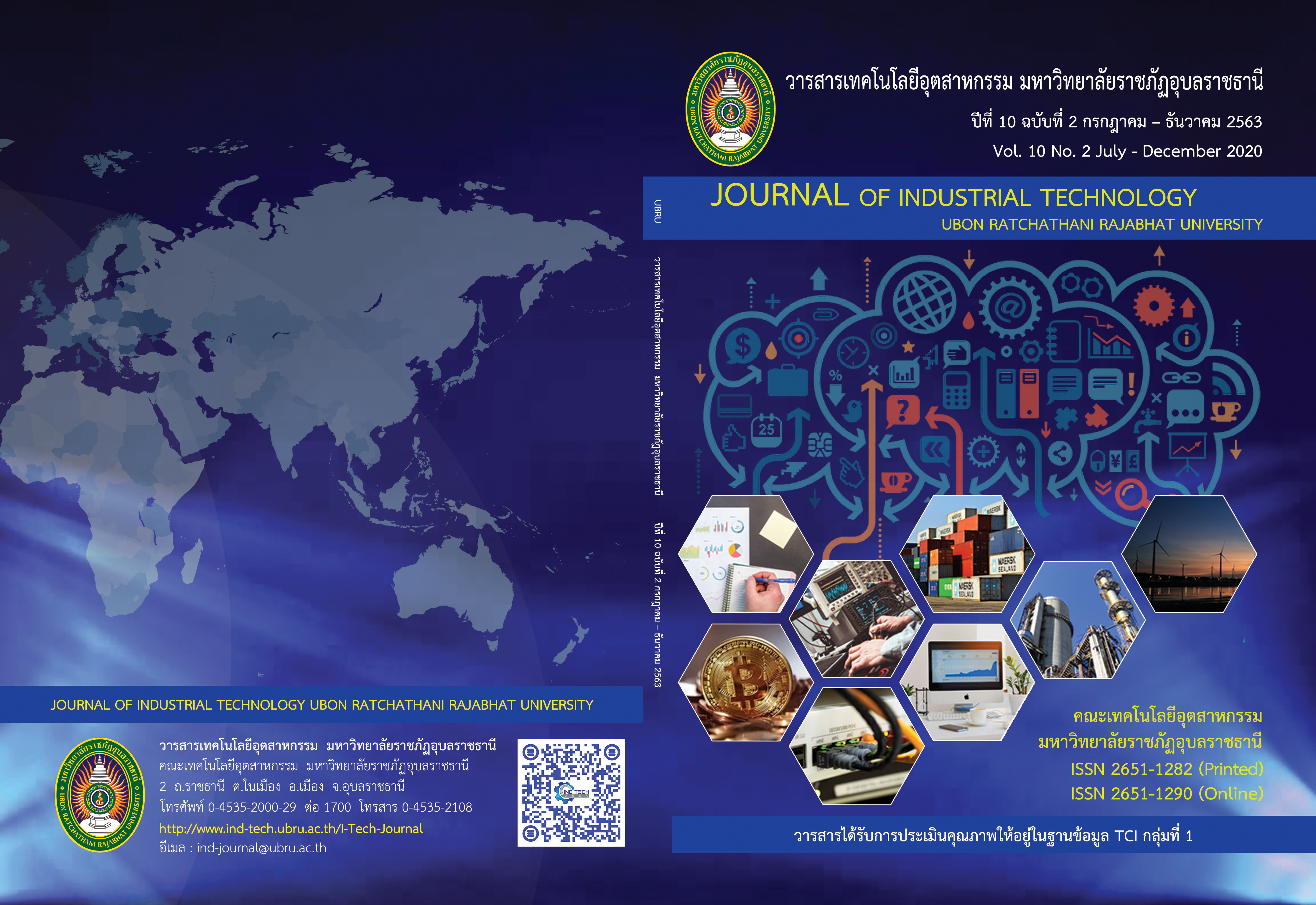การเพิ่มประสิทธิภาพการผลิตไฟฟ้าพลังงานลมในรอบปี ด้วยการกำหนดทิศรอลม ของกังหันลมจากค่าเฉลี่ยเลขคณิตของทิศลม
Main Article Content
บทคัดย่อ
ปัจจุบันการผลิตไฟฟ้าจากพลังงานลมเพิ่มขึ้นจาก 112 เมกกะวัตต์ ในปี พ.ศ. 2555 เป็น 234 เมกกะวัตต์ ในปี พ.ศ. 2558 และมีแนวโน้มมากขึ้น การลงทุนในการผลิตไฟฟ้าจากพลังงานลมยังจัดว่าสูงเมื่อเทียบกับพลังงานหมุนเวียนชนิดอื่น ดังนั้นการเพิ่มประสิทธิภาพในการผลิตไฟฟ้าจากพลังงานลมจึงถือเป็นหนึ่งแนวทางที่ช่วยลดระยะเวลาคืนทุน งานวิจัยนี้ เป็นการศึกษาการกำหนดทิศรอลมของกังหันลมโดยทดสอบค่าที่สงสัยด้วยวิธีของฮิวจ์ ในการคัดกรองข้อมูลเพื่อให้อยู่ในฐานข้อมูลเดียวกันและใช้ค่าเฉลี่ยเลขคณิตของทิศลมมากำหนดทิศรอลมเพื่อช่วยลดเวลาในการปรับหน้ากังหันเข้าหาทิศลม ซึ่งโดยปกติจะใช้เวลาประมาณ 5 ถึง 10 นาที ขึ้นอยู่กับตำแหน่งของหน้ากังหันก่อนหยุดทำงาน ผลการวิจัย พบว่า การกำหนดทิศรอลมของกังหันลมโดยใช้ค่าเฉลี่ยเลขคณิตของทิศลมสามารถลดเวลาในการปรับหน้ากังหันเข้าหาทิศลมหรือช่วยเพิ่มเวลาในการผลิตไฟฟ้าของกังหันลม การผลิตกระแสไฟฟ้าในเดือนมกราคม ถึง เดือนธันวาคม พ.ศ. 2561 เพิ่มขึ้น 1,830 นาที คิดเป็นกำลังการผลิตที่เพิ่มขึ้นเท่ากับ 7,332 กิโลวัตต์ชั่วโมง คิดเป็นร้อยละ 0.172 เมื่อเทียบกับข้อมูลที่บันทึกได้จากระบบสกาดา (SCADA) ดังนั้นวิธีการที่นำเสนอนี้สามารถใช้กำหนดทิศรอลมให้กับกังหันลมเพื่อเพิ่มประสิทธิภาพในการผลิตไฟฟ้าได้
Article Details

อนุญาตภายใต้เงื่อนไข Creative Commons Attribution-NonCommercial-NoDerivatives 4.0 International License.
บทความที่ได้รับการตีพิมพ์ในวารสารฯ ท้ังในรูปแบบของรูปเล่มและอิเล็กทรอนิกส์เป็นลิขสิทธิ์ของวารสารฯ
เอกสารอ้างอิง
Energy Policy and Planning office (EPPO). Ministry of Energy. Power Development Plan 2015 [Internet]. 2016 [cites 2019 January 10] available from: http://www.eppo.go.th/images/POLICY/PDF/PDP_TH.pdf (in Thai)
Department of Alternative Energy Development and Efficiency. Ministry of Energy. Alternative Energy Development Plan 2015 [Internet]. 2016 [cites 2019 January 10] available from: http://www.eppo.go.th/images/POLICY/PDF/AEDP2015.pdf (in Thai)
Phattaraphorn Hiranwong and Singhaphan Singhaseni. The future of electric power in Thailand, enough but risky [Internet]. 2015 [cites 2019 January 8] available from: https://www.bot.or.th/Thai/MonetaryPolicy/ArticleAndResearch/FAQ/FAQ_102.pdf (in Thai)
Mueangmon Nethan and Amphaisak Thibunma. Analysis and testing of wind turbine power generation efficiency of 800 watts. Journal of Science and Technology. Ubon Ratchathani University. 2011; 13(1): 57-65. (in Thai)
Phinit Sangthong and Wirachai Roinarin. Study of 1.5 MW wind turbine blades with fluid dynamics program. 8th Conference on Energy Network of Thailand (E-NETT2012); 2012 May 2-4; Faculty of Engineering. Mahasarakrm University; 2012. P. 1-7. (in Thai)
Worrapong Puangkaew, Jompob Waewsak , Chuleerat Kongruang, Chana Chancham, Nirundorn Matan, Yutthana Tirawanichakul and Supawan Tirawanichakul. Assessment of Wind Energy Resource and Feasibilityof Installing 0.225-0.75 MW Wind Power Plants along the Coast of Nakhon Si Thammarat and Songkhla Provinces. Thaksin University Journal; 2009-2010; 12(3): 129-137. (in Thai)
Chatchai Promdee and Chonlatee Photong. Electric Power Generation of Savonius Wind Turbine with Double Wind Tunnels. Academic journal engineering. Ubon Ratchathani University. 2016; 9(2): 18-29. (in Thai)
Porté-Agel F, Wu YT, Chen CH. A numerical study of the effects of wind direction on turbine wakes and power losses in a large wind farm. Energies. 2013; 6: 5297–5313.
Lee KY, Tsao SH, Tzeng CW, Lin HJ. Influence of the vertical wind and wind direction on the power output of a small vertical-axis wind turbine installed on the rooftop of a building. Applied Energy. 2018; 209: 383–391.
Xiang C, Tian-qi L, Fu-jun W, Zhen-huan C, Xiao-hu L, Tie-ying G, Suilin F, Zheng F. Wind power prediction considering the layout of the wind turbines and wind direction. Asia-Pacific Power and Energy Engineering Conference (APPEEC 2012); 2012 March 27-29; Shanghai. China: Institute of Electrical and Electronics Engineers (IEEE); 2012. p. 2716-2719.
Roulston MS, Kaplan DT, Hardenberg J, Smith LA. Using medium-range weather forcasts to improve the value of wind energy production. Renewable Energy. 2003; 28: 585-602.
Senjyu T, Sakamoto R, Urasaki N, Funabashi T, Fujita H, Sekine H. Output power leveling of wind turbine Generator for all operating regions by pitch angle control. IEEE Transactions on Energy Conversion. 2006; 21(2): 467-476.
Pahasa J and Ngamroo I. Model predictive control-based wind turbine blade pitch angle control for alleviation of frequency fluctuation in a smart grid. 2014 International Electrical Engineering Congress (iEECON 2014); 2014 March 19-21; Chonburi. Thailand: Institute of Electrical and Electronics Engineers (IEEE); 2014. p. 304-307.
Ponrawee Koetket, Somthawin Khunkhet, Werapon Chiracharit, Jompob Waewsak, Tanate Chaichana, and Yingrak Auttawaitkul. Determination of Wind Waiting Direction of Turbine by Using a Statistical Method for Increasing Time Span on Electricity Generating. 14th Conference on Energy Network of Thailand (E-NETT2018); 2018 June 13-15; Faculty of Engineering Rajamangala University of Technology Thanyaburi; 2018. P. 1097-1100. (in Thai)
Nanthana Kanyanuwat and Nutnat Nakham. Guidelines for checking the validity of chemical testing methods. Bangkok: Bureau of Basic Industries Department of Primary Industries and Mines; 2012. (in Thai)


